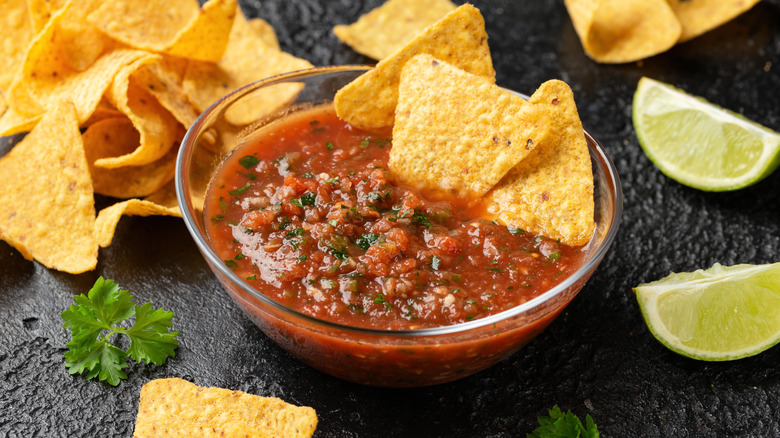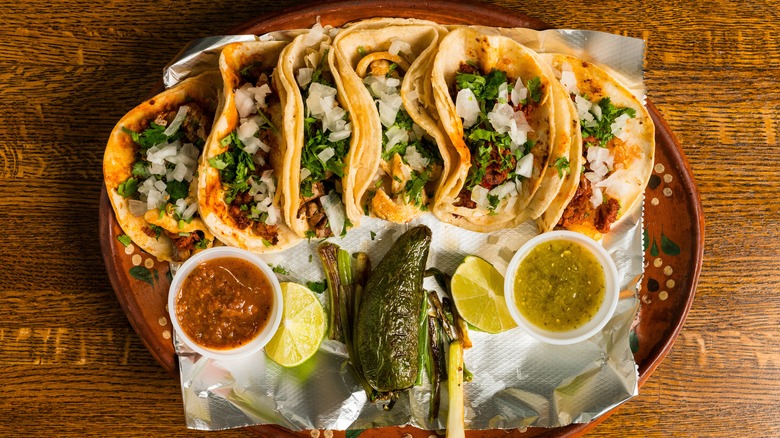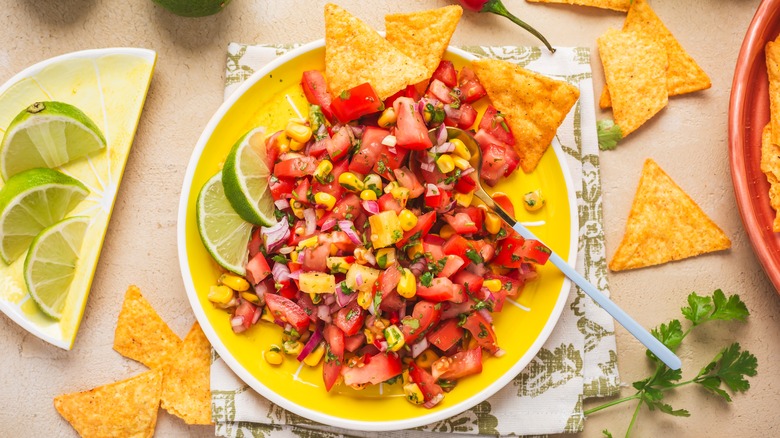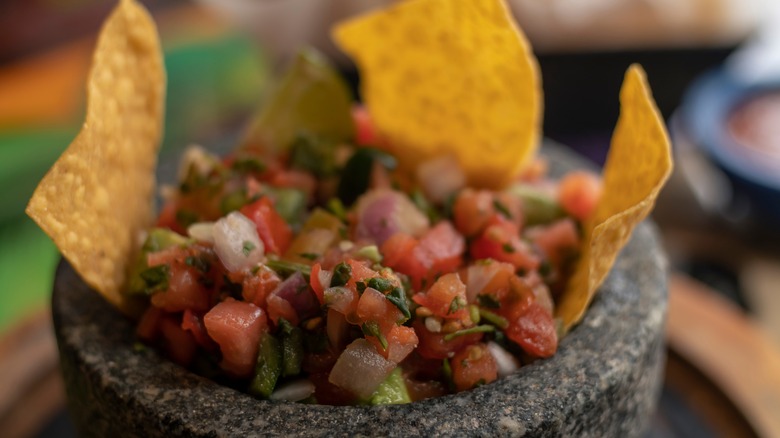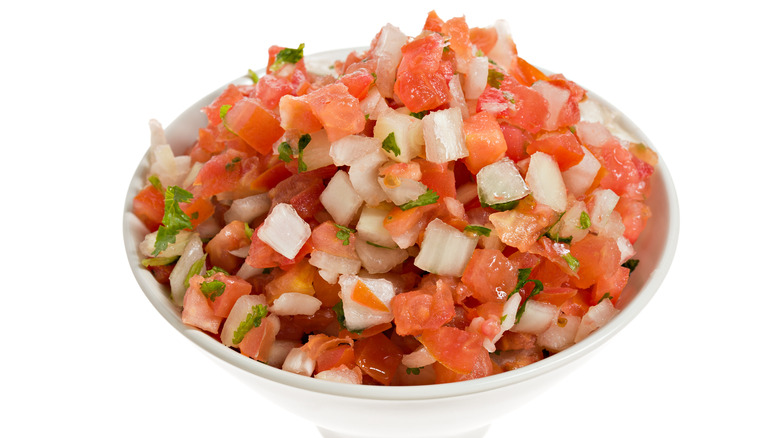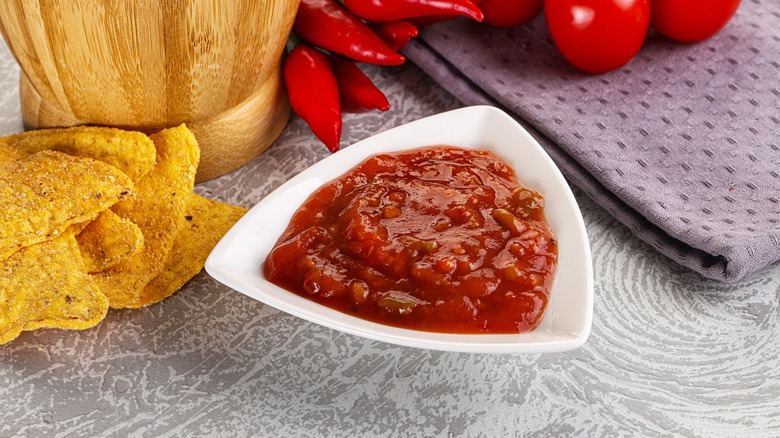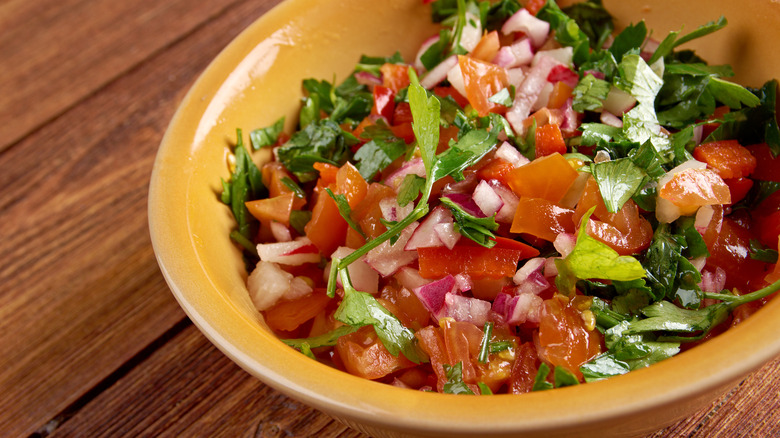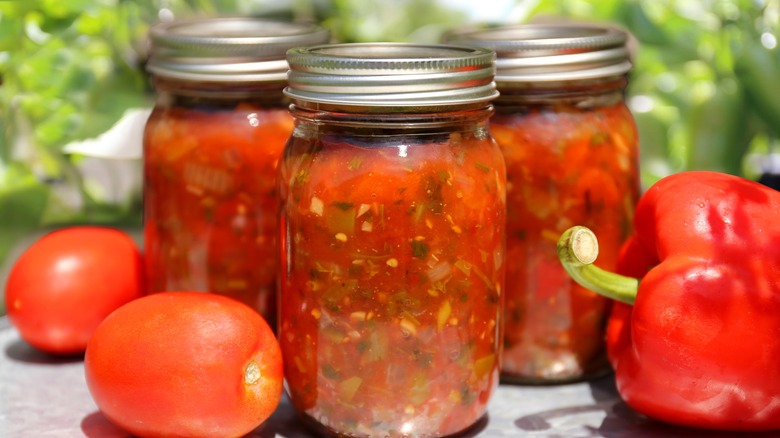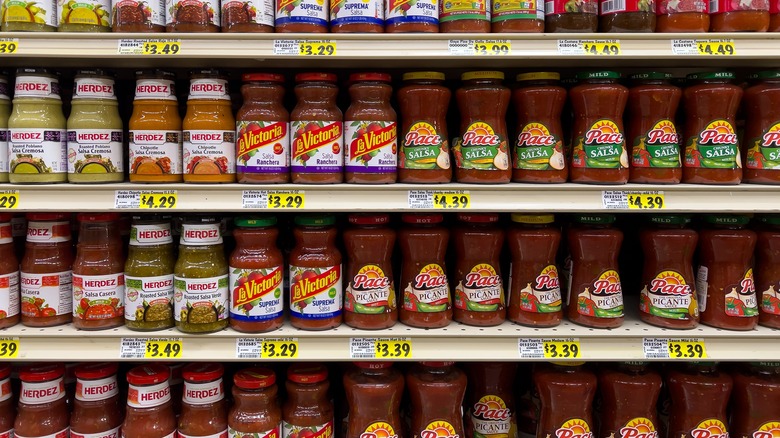What's The Difference Between Pico De Gallo And Salsa?
Salsa and pico de gallo are staples in Mexican cuisine, beloved for their vibrant flavors that elevate your favorite dishes. You'll find them gracing tables at Mexican restaurants, topping tacos, or served as dips for tortilla chips. But despite their popularity, these two condiments are often confused with one another, with many people using their names interchangeably. While the confusion is understandable, pico de gallo is actually a type of salsa with distinct characteristics that set it apart from other variations of salsa.
Understanding the differences between pico de gallo and salsa can help you better appreciate their unique qualities and utilize them more effectively in the kitchen. These differences extend beyond ingredients and preparation methods — they also cover aspects such as taste, texture, shelf life, and availability. For instance, salsa can range in spiciness from mild to fiery hot, and it's often cooked or blended to a smoother consistency. Pico de gallo, on the other hand, is a fresh, uncooked mixture that offers a chunky texture and crisp, bright flavors.
So, whether you're looking to add a spicy kick to your meal or a refreshing burst of flavor, knowing when to use salsa versus pico de gallo can elevate your cooking and dining experience. Explore the worlds of salsa and pico de gallo with us.
What is salsa?
You may already think you're very familiar with salsa. But what many of us don't realize is that this beloved condiment has roots that can be traced to ancient times, extending as far back as the Aztec civilization. The ancient Aztecs combined tomatoes, chili peppers, and ground squash seeds to create early versions of what we now know as salsa, using it to flavor their meals and as a condiment for meats and other dishes. The term "salsa" simply means "sauce," and it was coined during the Spanish colonization of Mexico in the 1500s.
Today, "salsa" is an umbrella term that covers a wide variety of sauces, each which bring a different flavor to the table. For instance, salsa roja (or red salsa) typically uses red tomatoes as its base, while salsa verde (or green salsa) is made with green tomatillos. The combination of ingredients, cooking methods, and flavors are virtually endless. Many salsas are cooked, while others are made fresh. You can even incorporate fresh fruits into your salsa recipe to make a fun sauce fit for summer.
Salsa's popularity has surged in recent years, establishing itself as one of the most popular condiments in American households. It's even used as an alternative to ketchup and has long surpassed it in terms of sales. Salsa's versatility allows it to enhance a wide range of dishes, from scrambled eggs and grilled fish to steak and roasted vegetables, making it a beloved staple across the country.
What is pico de gallo?
Now that we've established that salsa comes in many varieties, let's explore pico de gallo — which is actually a type of salsa. Often referred to as salsa fresca or salsa cruda, pico de gallo is a fresh, chunky version of salsa that brings a vibrant flavor and texture to dishes.
Pico de gallo translates to "rooster's bill" or "rooster's beak" in English, although the reason for that is still debated. Some say it's because of the way your hand looks when you use your fingers to eat it, while others believe it's due to the shape of the serrano pepper traditionally used in the dish. Regardless of its name's origin, what remains consistent is its refreshing taste and colorful presentation. Traditionally, pico de gallo resembles the Mexican flag, with its colors of red (from the tomatoes), white (from the onions), and green (from the cilantro and peppers).
A classic pico de gallo is made of white onion, tomatoes, cilantro, jalapeño or serrano peppers, and lime juice. These simple, fresh ingredients combine to create a salsa that is delicious and healthy, as it's packed with vitamins and antioxidants. But pico de gallo can be adapted. For example, you can add diced fruits for a sweet twist, or include other vegetables for added crunch and color. Just like other types of salsa, you can use pico de gallo to enhance any meal, especially those including chicken, fish, tacos, or tortilla chips.
Pico de gallo is a type of salsa
Pico de gallo is one of the many variations of salsa, standing out for its fresh preparation and chunky texture. While it is a popular and well-known type of salsa, it is just one example of how diverse and adaptable salsa can be. Beyond salsa roja and salsa verde mentioned earlier, the world of salsa includes many others, each with their own individual quirks and flavors.
Salsa taquera, for example, is specifically popular with tacos. It has a smooth, blended texture that makes it easy to drizzle over your favorite taco fillings with a spicy flavor that complements the savory tacos. Another popular variety is salsa ranchera, which is cooked and simmered until the flavors of its ingredients meld together, resulting in a thick, flavorful sauce made with tomatoes, onions, jalapeño or serrano, and spices. Salsa ranchera is often used as a topping for grilled meats, or as a flavorful addition to Mexican dishes like huevos rancheros.
Even as a type of salsa, pico de gallo also has its own variations. The traditional recipe includes white onion, tomatoes, cilantro, and jalapeño, all drizzled with fresh lime juice. However, you can experiment with different kinds of chiles to adjust the heat level, or add ingredients like avocado and cheese for a richer texture. Fruits like pineapples, mangos, or melons can also be incorporated to create a sweet and tangy twist, adding a refreshing contrast to the savory base ingredients.
Pico de gallo only features fresh ingredients
One of the defining characteristics of pico de gallo is its exclusive use of raw, uncooked ingredients. This simple preparation not only preserves the natural flavors of each ingredient but also contributes to its vibrant, refreshing taste and visual appeal.
The simplicity of making pico de gallo allows it to be easily prepared at home, without special cooking skills or equipment. Each ingredient is finely chopped and combined to create a colorful and flavorful salsa. The juicy sweetness of the tomatoes balances the sharpness of the onions and the heat of the jalapeños. Meanwhile, the cilantro adds a burst of freshness, and the lime juice provides a tangy acidity that ties all the flavors together. This fresh, raw salsa not only offers a light and healthy alternative, but also pairs beautifully with a variety of dishes, cutting through the richness of dishes like nachos.
In contrast, salsa can be made in various ways, including cooking, roasting, or pureeing the ingredients. Cooked salsas, such as salsa roja and salsa ranchera, often have a deeper, more concentrated flavor due to the cooking process, which melds the ingredients together. On the other hand, roasted salsas gain a smoky depth from the charred tomatoes.
Salsa can be spicier
One key difference between pico de gallo and salsa is their respective levels of spiciness. Salsa is known for its bold and spicy kick, as it often incorporates a variety of hot peppers such as jalapeños, serranos, or even spicier ones like habaneros. These peppers not only provide heat but also impart distinctive flavors, ranging from mild and earthy to intensely fiery and fruity.
The spiciness of salsa can vary depending on the type and quantity of peppers used, as well as their preparation. For instance, finely chopped or blended peppers tend to release more heat than larger chunks, affecting the overall spiciness of the salsa. Additionally, including the seeds and skin of peppers — which is often the case with blended or pureed salsas — can increase the spiciness.
In contrast, pico de gallo is generally milder. While it may contain jalapeño or serrano peppers for a hint of heat, pico de gallo typically excludes spicier peppers. This results in a fresh and tangy flavor profile that complements a wide range of dishes without overpowering the palate with spiciness. Pico de gallo preserves the natural and individual flavors of the ingredients, making it a perfect option for those who prefer a refreshing topping instead of an intensely spicy one.
Pico de gallo is chunkier
Another easily noticeable characteristic that sets pico de gallo apart from other types of salsa is its chunky consistency. Unlike other salsas that can be blended or cooked down, pico de gallo features roughly diced or chopped fresh ingredients.
This chunky texture gives pico de gallo a hearty and substantial feel, adding a satisfying crunch to dishes and making it ideal for scooping up with tortilla chips. It also allows pico de gallo to retain the distinct flavors and textures of each ingredient — you can taste the juicy sweetness of the tomatoes, the sharpness of the onions, the fresh brightness of the cilantro, and the heat of the peppers with every bite. Moreover, the way pico de gallo is prepared enhances its visual appeal. The chopped ingredients create a vibrant mix of colors that stand out against each other, making it visually enticing and appetizing.
In contrast, traditional salsa is often smoother and more liquid in texture. This is because salsa is typically made by blending or cooking the ingredients together, which breaks down the components into a more uniform mixture. The result is a sauce-like consistency that coats whatever it's served with.
Salsa may last longer, especially in the fridge
One of the key differences between pico de gallo and salsa is shelf life. Salsa is often cooked, which helps preserve it for a longer period. This cooking process helps to kill off bacteria, increasing the salsa's shelf life. A homemade salsa stored in an airtight container in the fridge, can last up to three days. Additionally, you can add more lime juice or add a hint of distilled vinegar, which can act as a natural preservative, and extends the shelf life to up to one week refrigerated. Store-bought salsas may last two to four weeks. That said, you should always still check for signs of mold, an unpleasant odor, or changes in color. These are signs the salsa is going bad.
Pico de gallo is fresh and uncooked, so it has a shorter shelf life and is best enjoyed soon after it's made. The chopped ingredients, especially tomatoes, can break down quickly, leading to a softer texture and a less vibrant appearance over time. It may last up to three days.
While refrigeration can help extend the shelf life of both pico de gallo and salsa, it's important to note that the texture and flavors of pico de gallo may change over time, even in the fridge. Some chefs recommend storing pico de gallo at room temperature to maintain its flavors and freshness, so it's best to not prepare it more than a couple of hours in advance.
Salsa is more widely and readily available
When it comes to availability, salsa has the upper hand over pico de gallo. Walk into any grocery store, and you'll likely find an array of salsa options lining the shelves. From mild to extra hot, from traditional red to verde, cooked to uncooked, and mango to pineapple, store-bought salsa is available in a variety of flavors and heat levels for every palate.
The widespread availability of salsa can be attributed to its longer shelf life and the fact that it is often cooked, which makes it easier to package and store. Store-bought salsas are typically enhanced with preservatives, making sure they remain safe and tasty for extended periods. This convenience means you can always have a jar of salsa on hand, ready to spice up your meals.
In contrast, pico de gallo is not as commonly found pre-packaged in stores. This is largely due to its fresh, uncooked nature. The fresh ingredients in pico de gallo, such as tomatoes, onions, and cilantro, are best enjoyed soon after preparation to maintain their vibrant flavors and crisp textures. Some stores may offer pre-made pico de gallo in their deli sections, and you can definitely check the best-by date and purchase these if you don't have the time to make it yourself. However, pico de gallo is often more appealing when prepared fresh at home, so you may prefer to make it yourself.
